Unsure if I understand the question but spzzzzk has a great tutorial in commands used in the umanager
http://www.diyaudio.com/forums/vend...magnitude-24-bit-384-khz-236.html#post4273014
If you wonder about the serial connection itself it is a good user guide here
https://hifiduino.wordpress.com/2015/03/16/soekris-dam-1021-r-2r-dac-users-guide/
Thanks bambadoo
I already read it.
upload bug?
Hi Søren,
I keep getting bitten by this one, so thought I should report.
I find if I cancel an upload for any reason (using zterm) uManager stops responding. The flashing underscore prompt disappears and the only way I can recover is to cycle power on the DAC. I thought I'd ride it out last time it happened, and after roughly 30 seconds the audio stopped completely, which suggests a lockup.
cheers
Paul
Hi Søren,
I keep getting bitten by this one, so thought I should report.
I find if I cancel an upload for any reason (using zterm) uManager stops responding. The flashing underscore prompt disappears and the only way I can recover is to cycle power on the DAC. I thought I'd ride it out last time it happened, and after roughly 30 seconds the audio stopped completely, which suggests a lockup.
cheers
Paul
Will be great if you (or someone else) give a short description of characteristics of those filters, warmth/bright, smooth/detail, forward/wide stage? etc, etc.
The difference between the recent filters is pretty subtle.
As an example compared to the stock filter:
EQMP_n017.skr sounds darker, richer and more substantial. The detail of the stock filter is still present but is balanced by slightly more natural sounding lower registers. You get the sense the mids are no longer too forward. Sound stage width is still roughly the same, perhaps slightly better than stock, however depth is significantly improved. There is good recovery of ambience and a sense of the recording venue, which the stock filter tends to lack. You'd have to say this was tending toward slightly smooth.
The other filters tend to be slightly lighter than the n017. It's difficult to describe each one as the general flavour is similar.
I'm not an audio journalist so I can't reel off effusive prose lauding the minutiae of each variation
It takes about 30-60 seconds to load up a new filter, so it's easy enough to swap and listen for yourself.
What I'd suggest is starting with either SoX HiAtt or the Kb16_BW. They are both make good references and there is little to choose between them.
From there try out the EQMP_n017, and EQ_n011
Digging back I'd definitely recommend listening to a couple of the Nyquist filters, they have a very nice transparency to them. I'm holding off until after the firmware update to do too much more with them, but they haven't been abandoned. Unfortunately hifiduino doesn't index the best of these...
NQ960_K180.skr (if it ever got uploaded) or NQ1008_C160_16_F2.skr are worth listening to. I'm less keen on the very short, slow roll-off Nyquist Filters as they seem compromised to a lesser or greater degree. Listening to the NQ1008_C160_16_F2.skr, I'd have to say it's probably best NQ filter to try.
Last edited:
The difference between the recent filters is pretty subtle.
As an example compared to the stock filter:
EQMP_n017.skr sounds darker, richer and more substantial. The detail of the stock filter is still present but is balanced by slightly more natural sounding lower registers. You get the sense the mids are no longer too forward. Sound stage width is still roughly the same, perhaps slightly better than stock, however depth is significantly improved. There is good recovery of ambience and a sense of the recording venue, which the stock filter tends to lack. You'd have to say this was tending toward slightly smooth.
The other filters tend to be slightly lighter than the n017. It's difficult to describe each one as the general flavour is similar.
I'm not an audio journalist so I can't reel off effusive prose lauding the minutiae of each variation
It takes about 30-60 seconds to load up a new filter, so it's easy enough to swap and listen for yourself.
What I'd suggest is starting with either SoX HiAtt or the Kb16_BW. They are both make good references and there is little to choose between them.
From there try out the EQMP_n017, and EQ_n011
Digging back I'd definitely recommend listening to a couple of the Nyquist filters, they have a very nice transparency to them. I'm holding off until after the firmware update to do too much more with them, but they haven't been abandoned. Unfortunately hifiduino doesn't index the best of these...
NQ960_K180.skr (if it ever got uploaded) or NQ1008_C160_16_F2.skr are worth listening to. I'm less keen on the very short, slow roll-off Nyquist Filters as they seem compromised to a lesser or greater degree. Listening to the NQ1008_C160_16_F2.skr, I'd have to say it's probably best NQ filter to try.
Thanks, will try those filters.
A word to the filters:
Mostly there are only different versions of the 44.1kHz and 48kHz filters.
Sometimes also the FIR2 filter is changed.
The filters for the higher sample rates change here and there, but here the situation is a bit unclear.
The FIR2 has been altered from stock in every filter for the last 2+ months. And I do alter the F2 to suit the general filter type. The EQ filters have an equiripple Fir2, and Nyquist Filters use a Nyquist Fir2 for example.
Due to the higher sampling rates the filters at these frequencies are not subject to the same kinds of trade offs and compromises that effect the x1 sampling rates.
I take the view that it's a bit hard to do the filters at the higher sampling rates wrong, so there isn't nearly as much to be gained by messing with them. So I don't spend that much time on them. The fact I only have 2-3 recordings at 88.1 and 1 at 192kHz plays a part too.
And lets not forget this is a DIY forum. I'm DIYing what I have an interest in. If anyone doesn't like what I'm doing or wants a glittering array of 192kHz filters to pick from, there is nothing stopping them from making their own...
Hi Søren,
Could you tell which (if any) pin of J10 does provide either 5V or 3.3V power supply?
Thanks,

From GLT's blog and it's J2.
Last edited:
From GLT's blog and it's J2.
Yeah, I know there is J2. But I find it more convenient to have power supply at J10 as I plan to use digital isolator for rs232.
Yeah, I know there is J2. But I find it more convenient to have power supply at J10 as I plan to use digital isolator for rs232.
I guess you don't want to wait for the next firmware release to use the isolated rs232 pins in J10?
In either case, just go to GLT's blog. It covers the info you need. I'm not sure if the 3.3v for the pot can be used for your purposes. How are you currently powering the dirty side of the isolators in the DAM1021? Can't you just use that same supply?
I did a few more measurements ... some new insight on the peak around 39kHz.
I supplied a balanced mono signal 1kHz, 24bit, fs=384kHz, from the raw output (by inverting the signal on one channel) to a balanced input of a Fireface 800.
The main change in the setup, compared to my last measurements, is that I now used a screened balanced cable directly connected to the raw output header, instead of using two chinch cables from the SE out in an chinch-stereo-TRS-adapter. I also connected, with an separate wire, the Fireface and DAM chassis, which removes the 50 Hz spike from the Fireface noise floor, which was visible otherwise when the DAM was powered on (even when not connected).
As result, the noise floor of the RME, with input shorted, is nearly identical to the measurement with the DAM, connected, with no signal played, except of a small 50Hz spike and harmonics.
The first picture is a overlay of the noise floor (green) and the DAM with no signal (red) with 27dB analog gain at the input of the ADC. The second the same in the old setup
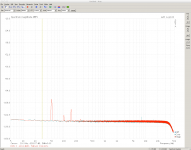
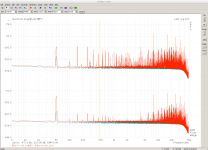
Using other gain or the fixed gain inputs of the Fireface results also in identical noise floors except the 50 Hz spike.
Next a -60 dB signal over the no-sigal floor ... only harmonics of the 1kHz appear,
First picture with 27bB analog gain. Second, same input, gain adjusted, such the 60db spike is at 60dB. Third with the fixed gain inputs.
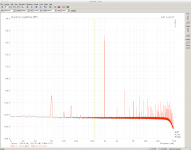
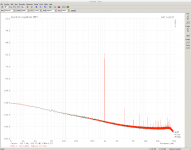
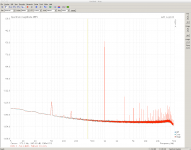
Next a -1 dB signal on the fixed inputs over the corresponding noise floor.
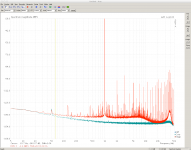
This was with a dithered signal (green in the next picture), with an undithered signal (red) the peak at 39kHz is gone (no idea why). This does not change with different FIR2 filters.
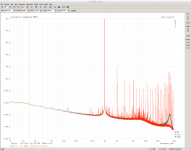
I supplied a balanced mono signal 1kHz, 24bit, fs=384kHz, from the raw output (by inverting the signal on one channel) to a balanced input of a Fireface 800.
The main change in the setup, compared to my last measurements, is that I now used a screened balanced cable directly connected to the raw output header, instead of using two chinch cables from the SE out in an chinch-stereo-TRS-adapter. I also connected, with an separate wire, the Fireface and DAM chassis, which removes the 50 Hz spike from the Fireface noise floor, which was visible otherwise when the DAM was powered on (even when not connected).
As result, the noise floor of the RME, with input shorted, is nearly identical to the measurement with the DAM, connected, with no signal played, except of a small 50Hz spike and harmonics.
The first picture is a overlay of the noise floor (green) and the DAM with no signal (red) with 27dB analog gain at the input of the ADC. The second the same in the old setup


Using other gain or the fixed gain inputs of the Fireface results also in identical noise floors except the 50 Hz spike.
Next a -60 dB signal over the no-sigal floor ... only harmonics of the 1kHz appear,
First picture with 27bB analog gain. Second, same input, gain adjusted, such the 60db spike is at 60dB. Third with the fixed gain inputs.



Next a -1 dB signal on the fixed inputs over the corresponding noise floor.

This was with a dithered signal (green in the next picture), with an undithered signal (red) the peak at 39kHz is gone (no idea why). This does not change with different FIR2 filters.

Last edited:
P.S.
Notice that for the -1dB signal, the dithering reduces the even harmonics:
....... dithered, undithered
2nd: -97dB ......... -77dB
3rd:. -91dB ......... -91 dB
(you need to add 3dB to the graph readings, the -1dB peak is displayed at -4dB).
Dithering removes the quantization induced part of the harmonics, so something like that was to be expected. I only did not notice it before as I mainly measured lower level signals before, e.g for the -60dB signal dithering makes no noticeable difference.
Notice that for the -1dB signal, the dithering reduces the even harmonics:
....... dithered, undithered
2nd: -97dB ......... -77dB
3rd:. -91dB ......... -91 dB
(you need to add 3dB to the graph readings, the -1dB peak is displayed at -4dB).
Dithering removes the quantization induced part of the harmonics, so something like that was to be expected. I only did not notice it before as I mainly measured lower level signals before, e.g for the -60dB signal dithering makes no noticeable difference.
Last edited:
PPS. @Soren
In the light of this it might be worth to test the effect of dithering, when decimating the FPGA calculation to the 28 bits of the DAC ladder (as also spzzzzkt "suggested" in the filter thread). A shift register based pseudo random generator does take not much resources, so dithering should be cheap. If there is some visible effect, perhaps it would be a nice further option chooseable with the uMangaer.
In the light of this it might be worth to test the effect of dithering, when decimating the FPGA calculation to the 28 bits of the DAC ladder (as also spzzzzkt "suggested" in the filter thread). A shift register based pseudo random generator does take not much resources, so dithering should be cheap. If there is some visible effect, perhaps it would be a nice further option chooseable with the uMangaer.
I am finding I have intermittent power up issues with the DAM. On occasions when it powers up the sound is very distorted. When this occurs I have to cycle the power many times to work around this. Sometimes I have to wait 20 seconds or more between power cycles until I get a normal power up. I have tried a number of different power supplies including the recommended 7V/7VA toroidal transformer and the issue persists with all of them. Has anybody else experienced this?
I guess you don't want to wait for the next firmware release to use the isolated rs232 pins in J10?
My understanding is that the next firmware will use J3 pins for bi-directional isolated communication, not those of J10.
In either case, just go to GLT's blog. It covers the info you need. I'm not sure if the 3.3v for the pot can be used for your purposes. How are you currently powering the dirty side of the isolators in the DAM1021? Can't you just use that same supply?
I need a power supply for a clean (dac) side of isolator. Not the other way around.
My understanding is that the next firmware will use J3 pins for bi-directional isolated communication, not those of J10.
I'm sorry, I got it mixed up. J10 is only for the rs232 interface, so yes, the isolated pins are in J3
I need a power supply for a clean (dac) side of isolator. Not the other way around.
RE: J10, Soren has remarked before that J10 is configured exactly like a PC's serial com port. I tried googling for some info there and unfortunately couldn't find something that may be useful (except for powered RS232 which I'm not sure applies here... it indicated pins 1 and 9 as a possibility if you care to test with a DMM). If you're not willing to tap from other connectors, you may have to just measure all the pins against ground in J10.
Sorry can't help more there
P.S.
Notice that for the -1dB signal, the dithering reduces the even harmonics:...
I made an error here, by looking at graphs from different measurements (the dithered over noise is from the fixed inputs and the dither non-dither overlay is from the variable inputs).
Lokking at the difference of dithered and non-dithered (from the same input) shows that the differnce is essentially only that 39 kHz peaked hump - no change in the harmonics.
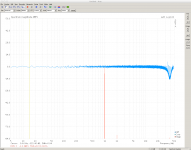
Last edited:
This was with a dithered signal (green in the next picture), with an undithered signal (red) the peak at 39kHz is gone (no idea why). This does not change with different FIR2 filters.
View attachment 485747
May you provide 2 individual plots one with dither and undither. While the graphs are over painted...
For my understanding, all gain alternation requires a proper dither otherwise artifacts will be present..
Hp
- Home
- Vendor's Bazaar
- Reference DAC Module - Discrete R-2R Sign Magnitude 24 bit 384 KHz